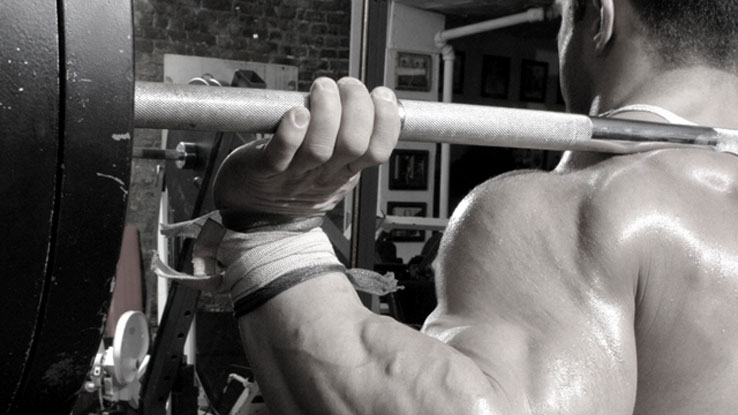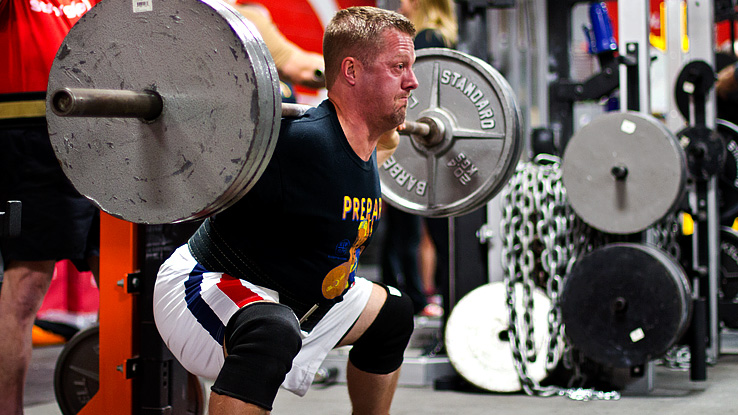My name is Ben Bruno and I'm a training addict.
I admit it, and I make no apologies for it. I have no intention of quitting, either.
There are many reasons why I love training, but perhaps the biggest is the fact that you can always improve. Whether it's getting stronger, moving better, getting leaner, or getting bigger, you can always find something that you could be doing better. This may turn some people off or drive them to a different hobby, but to me it's what makes the iron game so awesome and keeps me coming back day after day, year after year.
It ain't like Xbox where you can beat the game, but rather a never-ending quest for self-improvement. If you want to be successful, you have to learn to embrace the process and not just the end result – because you'll probably never get to where you want to be. You may get to where you thought you wanted to be at one point, but once you arrive, you'll inevitably want more and look for new ways to help take you even further.
Improvement requires change, and change can be tricky. Change too much and it can throw off your forward progress, making it hard to know what works and what doesn't. Change too little and you stay mired in mediocrity. The key is to make small yet substantive changes to keep propelling you forward in the right direction.
To help you improve upon your training program, I've shared one helpful change I made in my training in the last year (below) and polled some other coaches to do the same.
The biggest thing I've changed is to quit obsessing about progressive overload.
Sure, I want to keep getting stronger and more muscular, but I realize that I'm not going to set a record every time I go to the gym. Around once per month, I'll see if I can set a personal record on squats, bench press, deadlifts, or weighted neutral grip pull ups. However, I'm done trying to use more weight for exercises like lateral raises, rear delt raises, pullovers, shrugs, and hammer curls.
I've been lifting for 20 years, and I'm comfortable with the weights that I use on these exercises. For example, sometimes I might do lateral raises with some body English where I use the 50's, while other times I might be ultra-strict and use the 30's. I don't really care if I ever get stronger at them as my progressive overload efforts are focused solely on squat, bench press, and deadlift variations.
I'd still like to get stronger on certain lower body assistance lifts that transfer to my deadlift, such as hip thrusts, back raises, and reverse hypers, as well as any upper body assistance lifts that transfer to my bench press such as incline presses and close grip bench presses, but I don't force it.
Assuming that you're a natural lifter and have been training for over a decade, you won't go up in strength on every single exercise each year. Some years you'll get stronger at a few key lifts, the next year you'll stagnate but gain significant strength on others. As long as you're consistent and train intelligently, you should get stronger at a handful of exercises each year and your physique will continue to improve for many years to come.
But you need to keep your joints healthy and use good form if you want to stay in the game. I've seen too many lifters get hurt by obsessing about getting stronger, to the point where they stubbornly move up in weight on an exercise when they're not ready for it.
For example, they'll barely be able to squat 315 for 5 reps but they'll still move up to 325 the following week and allow the torso to lean more forward. The week after that they'll move up to 335, eventually turning the lift into a "squat-morning." Lifters like this aren't really getting stronger; they're just resorting to sloppier form, which is the chief culprit of weight lifting injuries.
One thing I've changed this year is my eating patterns.
For years, I've eaten between six and nine meals per day, depending on my goal. Now, it's two to four. Much of this is coming from my interest in intermittent fasting, and seeing how small I can make my eating window. I've found that on non-training days I really like a small window of about six hours where I eat maybe two meals. On training days, I expand that to as long as nine hours and eat three meals (four if you count my peri-workout nutrition, which is mostly liquid).
But more than anything else, with both diet and training, I realize that it's important to come up with your own workable version of something. When I practice IF, I have cheat days, warrior diet days, and periods with 36-60 hours of fasting. I constantly experiment, and so I've come up with my own synthesis of what I find works exceptionally well for my lifestyle.
I still follow a lot of my old rules – I tend not to eat a lot of carbs and fat together, for example. I just find this is a helpful way to structure meals because it gives me a workable frame work. I still plan meals in advance, bodybuilder style. I still eat some protein and fat before bed.
Stuff like that has worked for me, and while it's admittedly a little bro-sciency, and none of it increases efficacy too much, it helps increase my compliance and I'm comfortable with it. And for the record, I simply don't give a shit what anyone says. I guess I'd rather be a "bro" who gets results than a know-it-all asshole arguing on the internet.
For the first time ever this year, I hired a coach.
In the past, I'd always written my own programs. And in all fairness, I'd done pretty well for myself. When I was powerlifting regularly back in 2005, I'd built myself up to numbers of 530/335/535 at a bodyweight of 198 pounds.
Not bad, but not earth-shattering either.
However, things have changed a lot for me since then. I started two businesses, a family, and just have a lot more responsibilities.
As a result, writing my own programs was no longer fun, and I felt like to some degree, I'd lost the ability to be objective about my own training.
After my last powerlifting meet, I hired Mike Tuscherer to write my programs. Not only has this freed up a bit of time, but it allows me to remove my own biases from the program.
Now, instead of using my pet exercises or set/rep schemes, I have someone to tell me exactly what to do. This has allowed me to distance myself a bit from my programs and at the same time, apply myself even more wholly to the program itself.
Finally, the built-in accountability is another nice bonus. I feel like if I miss a training session, I'm not just letting myself down – I'm letting my coach down as well.

The biggest thing I changed this year was the inclusion of even more band work.
My first experience with bands was at Westside Barbell working with Louie Simmons. Louie taught me that bands are great for developing speed strength and force production.
If implemented in the right manner, however, they can also be used for hypertrophy training. See, the eccentric portion of the lift is where you break down the most muscle fibers and create the most potential to remodel a bigger and better muscle, but heavy eccentric training can be dangerous. You wouldn't want to have someone push down on the bar while you lowered a bench press or you'd probably pop something.
The bands accommodate the strength curve, making it safer. A few years ago, I got two "light" bands from EliteFTS and began playing around with them. I liked them because, put simply, they made stuff harder to do.
Here's what I really liked though; used in certain ways, they made the muscle contract harder and longer. The strength curve goes out the window. There's no easy part of the movement.
I then started playing around with sets and reps and figured out a few things. I didn't like really high reps (simply too taxing), but sets of 5-8 seemed to spur new growth in myself and my clients.
I also discovered that the intensity the bands generated can wear you down quickly, so it's prudent to use them for shorter blocks, maybe about six weeks at a time. To me, this is perfect for bodybuilders or anyone looking to put on muscle and increase intensity.
The first exercise I put to the test was banded leg presses. It was cool to have to fight the extra resistance as the weight came down. At the bottom the bands loosen up so you can fire out of the hole, but as you progress through the rep, the bands create more tension as you approach lockout.
At that point, I called Dave Tate up and asked him for a full set of bands and the creative juices just started flowing. Shortly thereafter, I started training with Dave, who like me, is always looking for ways to make things harder, so we began to rig up bands on just about everything you can think of from JM presses to toe presses in a leg press for calves.
We eventually figured out what we liked and continue to use those exercises. I've made them a permanent part of my program, and the results have been excellent.
One thing that's really changed for me lately has been my approach towards flexion, specifically spinal flexion.
Like many, I started avoiding flexion after reading much of Dr. Stuart McGill's research on spinal mechanics. For those who've been living under a rock for the better part of the past decade, Dr. McGill showed that repetitive spinal flexion is the exact mechanism for disc herniations and bulges. For instance, when someone performs a sit-up, they're placing upwards of 3300 N (roughly 760 lbs) of compressive load on the lumbar spine.
After learning this, if I witnessed a client flexing his or her spine in any way, shape, or form, I'd practically start hyperventilating. However, it reached a point where I believe I was missing the forest for the trees, and taking this whole, "OMG don't flex your spine," thing a little too far.
This isn't to say that I don't feel McGill's work should be the basis for most fitness professionals' approach to core training. Far from it. Our society lives in flexion enough as it is, and I'd be remiss not to recognize that the main "function" of our core is to resist rotation, flexion, and extension.
Interestingly, this past summer, my good friend (and business partner) Eric Cressey and I noticed something that caught our eyes while we were looking at some before and after shots of our college baseball guys.
Namely, we noticed that many exhibited some significant anterior pelvic tilt, not to mention an abdominal distension. This is in spite of them all doing their fair share of Pallof presses, various chops/lifts, planks, and other anti-rotation and anti-flexion exercises.
We delved into our programming and picked through it with a fine comb, and came to the realization that we weren't including enough anterior core work. It's not that we weren't targeting the anterior core enough; rather, we weren't doing much (if any) direct work for the external obliques, which help posteriorly tilt the pelvis, and, in essence, help bring people back to a more neutral spinal position (when in excessive anterior tilt).
Enter Reverse Crunches!
Yes, reverse crunches promote spinal flexion, but unlike the rectus abdominus – which has direct attachments to the sternum, and as a result, depresses the rib cage to a great degree – the external obliques don't. So, we can get all the benefits of training the anterior core and help to promote more posterior tilting of the pelvis without all the drawbacks that come with "spinal flexion."
Of course, as with any exercise, you must consider any contraindications a trainee may have. For instance, I wouldn't use reverse crunches with people who sit all day in front of a computer, and as such, already live in posterior tilt.
Again, we're just trying to get people back to more of a neutral spinal position and help alleviate excessive anterior tilt.
In short, given the right circumstance, some spinal flexion is okay. It's not the end of the world.
Sometimes a training change comes from learning something completely new, while other times it's just a matter of implementing something you already knew but hadn't yet put into practice.
The latter was the case with me this year.
For the past several years, I've known that it's a good idea to incorporate more pulling than pressing into your routine. I'd even recommended that others do it, but never did it myself.
Why? The same reasons you probably don't do it, either:
- Pressing is fun. It's sexy. Pulling, well, isn't.
- People wanna know how much you bench. I've never had anyone ask how much I row.
- A big chest and massive shoulders look impressive. A big back does too, but you can't see it. If you can't see it, who cares, right?
This year, I finally did what I knew I should've been doing all along.
I originally tried it after tweaking my shoulder doing a heavy one-arm dumbbell press. Luckily it wasn't too bad, and it turned out to be a blessing in disguise because it pushed me to reconsider my training program. I'd always read from the experts (a lot of them here on T Nation) that incorporating more pulling than pressing would go a long way in warding off shoulder issues, so I figured it was worth a shot.
It has. My shoulders have felt great all year. [knock on wood]
As a bonus, the added upper back strength has had a tremendous carryover to my other lifts.
Typically, when you hear the ideal relationship of pulling to pushing, it's connected to a ratio based on total volume in a training program. I've heard a lot of different ratios thrown around: 3:2, 2:1, or even 3:1. While I believe it's a good idea to do more pulling than pressing, to me, it shouldn't just be about volume; it should be about quality work.
It's not enough to slog through six half-assed sets of chin-ups or rows at the end of a heavy pressing workout. You need to focus on getting stronger on your pulling movements, and, more importantly, doing them correctly.
If you're going through the motions but aren't retracting your scapulae on each rep, keeping your chest puffed out, and consciously thinking about pulling your elbows down and back, you're missing the point and wasting your time.
It's not about fulfilling some magical ratio; it's about strengthening your upper back muscles. Remember that.
The takeaway here is three-fold.
- If you aren't doing enough pulling in your program, do it.
- In all things training-related, think quality over quantity.
- Sometimes the most important change you can make is just starting to do what you know you should've been doing already.
I hope this article has given you a few tips that you can put to use in your own lives. I suggest not upending your whole routine and trying to incorporate all these ideas at once, but perhaps throwing in one or two that really stick out or resonate with you.
At the very least, use this article as an impetus to sit down and figure out where you're currently falling short, and more importantly, how you're going to improve it.
Good luck!





